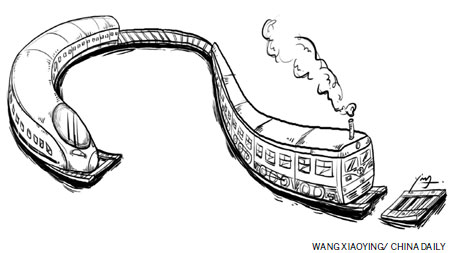What lies ahead of China's railways?
By John Scales (China Daily) Updated: 2012-01-13 08:08

The Spring Festival travel season, or chunyun, is back and a total of 3.1 billion trips are expected during the 40-day peak season. It's understandable that for many it is hard to get a train ticket as China's railway system not only carries the largest and fastest growing volume of traffic of any major railway in the world, it also is by far the busiest. It carries nearly three times the volume of traffic on an average kilometer of rails as the US rail network, and about 10 times that of the European Union.
Despite substantial investment since 1949, China's railway route length compared to its land area is still one-third that of the US and only one-sixth that of the EU. More strikingly, its route length per citizen is less than one-twelfth that of the US and one-seventh that of the EU. No wonder, China's rail network is used so heavily. Indeed, its capacity is effectively rationed on many routes, something that will be readily attested by many passengers waiting for seats and freight shippers unable to get all the wagons they would like.
With such high utilization and growing traffic, China has no choice but to build new lines in its main inter-city corridors. The question is, whether the new lines should be built for traditional-speed or high-speed railways. Building high-speed railway normally costs more than building traditional rail infrastructure. But in China the incremental cost, usually considerable, is not prohibitive partly because most new lines are built on viaduct and through tunnels to minimize the use of land whether for traditional-speed or high-speed railways. Moreover, new lines built for traditional-speed trains only provide capacity, not better services, to meet the increasing competition from road and air transport. That's why nowhere in the world new inter-city rail lines are being built for traditional-speed trains.
Internationally, high-speed trains have competed successfully with buses and planes as the mode of transport. The central and coastal regions of China have just about the most favorable demographic and geographic conditions for high-speed rail network to succeed, for it will connect 15 cities with populations of 3 million or more each and 50 cities with populations of more than 1 million.
This pattern of inter-city journey is favorable for the railways. Also, rapidly growing personal disposable incomes will create demand for travel. This should augur well for the long-term economic viability of China's high-speed rail network, which just after four years can be compared to that of the French high-speed rail network in volume. With that said, many people doubt the rapid development of high-speed railway in China after the high-speed train accident in Wenzhou on July 23, 2011, which the State Administration of Work Safety in its December report blamed on technological as well as human failures. Much needs to be done and should be done to ensure that such an accident does not recur. Internationally, high-speed rail technology has an excellent safety record, and the fact that it is much safer that road transport is one of its big positives. Hence, the high-speed rail program with strengthened oversight should remain a critical component of China's land transport strategy.
High-speed rail traffic will certainly continue to expand as the lines under construction are completed and networks joined. Besides, economic growth and rising incomes will ensure increasing long-term utilization.
In the interim, any unused capacity can be filled through market-based pricing, allowing a wider spectrum of Chinese people to reap the benefits of high-speed railways. It will be attractive for trips that would otherwise be undertaken by road or air, and contribute to a safer and less carbon-intensive transport system.
Finally, shifting passenger transport to the high-speed network will increase the capacity for rail freight on the traditional-speed rail network and relieve the pressure on the expressway system in the busiest corridors.
The development of railways in China faces several challenges. First among them, as the Wenzhou accident showed, is of safety and reliability of the high-speed rail network. Second, it is important to establish a durable funding model which recognizes that infrastructure built to last and serve a century cannot start paying back during its first handful of years.
To this end, the high-speed rail program should be consolidated into a "tighter" network covering priority routes with the highest returns, while making more effective use of long-term financing instruments.
The author is China transport sector coordinator at World Bank Office, Beijing.
(China Daily 01/13/2012 page9)











